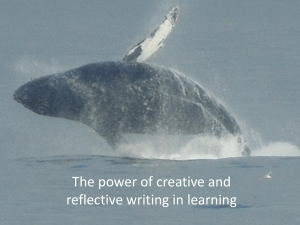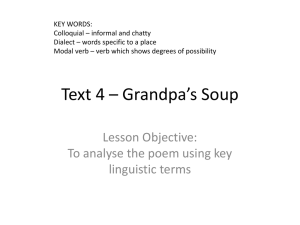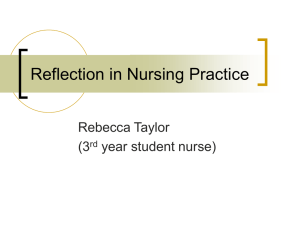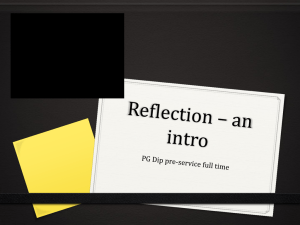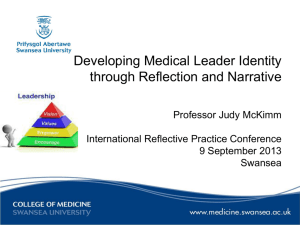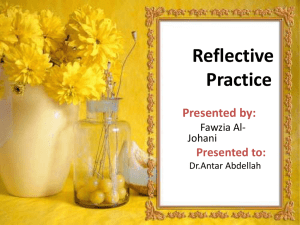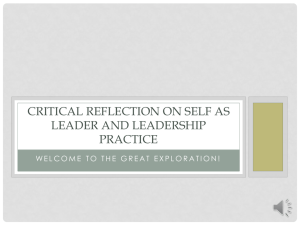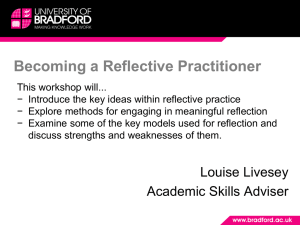Narrative Medicine - Hofstra North Shore
advertisement
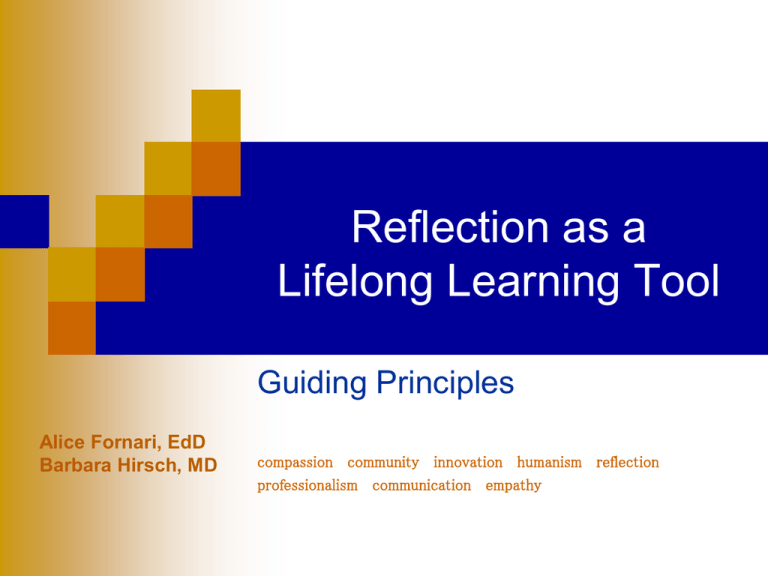
Reflection as a Lifelong Learning Tool Guiding Principles Alice Fornari, EdD Barbara Hirsch, MD compassion community innovation humanism reflection professionalism communication empathy Reflection as a SOM Value “We are committed to embedding in all our learning experiences the time and skills necessary to consciously examine, interpret and understand the thoughts and feelings that emanate from intense patient encounters. Through this process of mentored self-reflection and assessment, we ensure the development of a true learning and professional community capable of nurturing the transformation from student to physician.” Objectives 1. Explore Narrative Practices as integral to humanistic and patient centered care. 2. Actively experience reflective practice tools using a prompt and poem/story to engage in reflective practice. 3. Identify the use of Narrative Practice as a teaching and learning tool across medical education (CME, GME, UGME) Relevant Lifecentered/Real Stories Selfdiscovery *ANDROGOGY *Teaching Adults Past experiences Selfdirected learning NARRATIVE PRACTICE Narrative Competence MINDFULNESS REFLECTION Goal: A Community of Reflective Discourse Reflective Practitioner ReflectionON-Action (requires planning in “off time” ReflectionIN-Action (occurs daily in “real time”) Let us Begin to Experience Reflection… PROMPT as a Tool: Facilitator Begins with General Guidelines 1. 2. 3. Write freely, everything said in this session is confidential Write within the allotted time (7 min.) Don’t worry about “getting the prompt right” Reflective Process #1: PROMPT Write about a time where you felt a loss of control. Prompts in Narrative Medicine A simple invitation to write : “tell the story of your name” Prompts should be open ended to allow writing at any level Timing should be limited for written response Sharing of writing in small groups facilitates the reflective process Journals can be encouraged PROMPT as a Tool: General Guidelines 1. Reading – no preamble, no explanations, no adlibbing; just read as written. 2. Feedback/Questions – 1. 2. 3. 3. Base on the text only, do not assume the writer is the narrator Use neutral, passive language Start with positives follow with questions Writer’s Response – You do NOT have to answer any questions Storytelling is universal across cultures: Why read stories/poems? close attention to detail as we construct meaning highlight the subtlety & ambiguity of words & language embody themes encountered by clinicians stretch our worldview & allow us to experience/ imagine the unfamiliar Reflective process #2: POEM as a Tool Fleeing Alzheimer’s Authored by Sandra Miller Read the story/poem from start to finish twice : savour the experience Read & Reflect How to Approach a Story or Poem ① Note feelings, thoughts and points of curiosity ② Which character(s) stand(s) out for you? What is the context/setting/worldview of the story? ④ Add a Prompt: Write about a time you forgot something? ③ Are these tools realistic in Clinical Education/Practice? Music Media Stories Poetry Art Stimuli for reflective practice leading to humanistic patient-centered care 4 Domains Supported by Reflective Practice Relationships Behaviors Provider-Society Professionalism ProviderColleagues Listening Provider-Self Trust Provider-Patient Empathy Narrative Rounds: Promoting Humanism in Healthcare Ephraim Rubenstein, MFA Tuesday, January 15th, 2013 Art and Medicine Professor at Columbia University’s Department of Narrative Medicine Narrateur: Reflections on Healthcare The Hofstra North Shore-LIJ School of Medicine Literary Journal http://www.narrateur.org Open to all in the SOM and Health System Second submission due date December 1, 2012, with March publication
